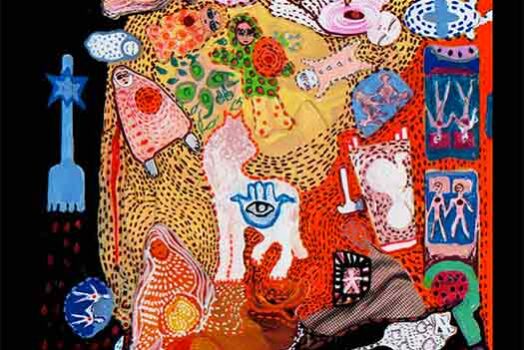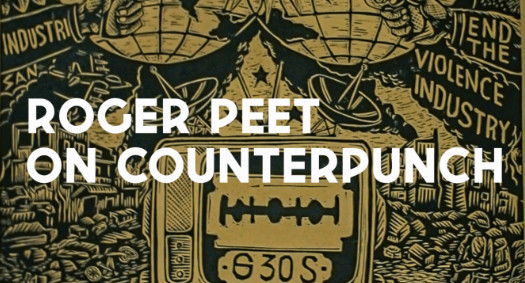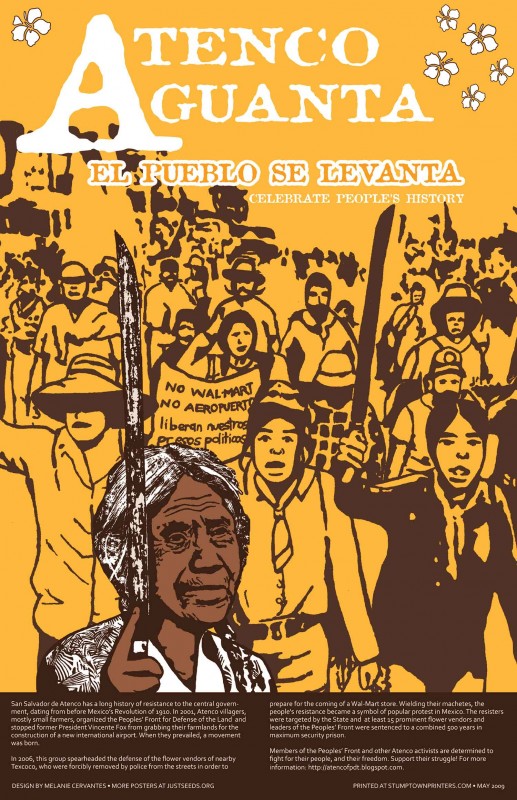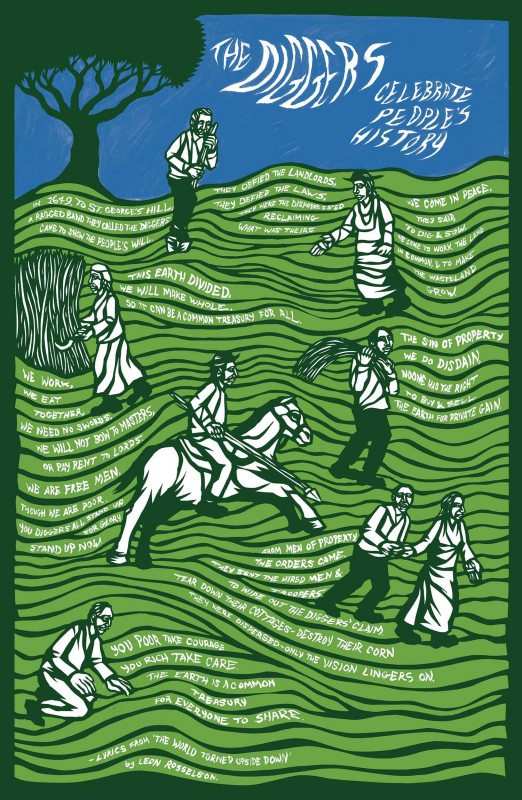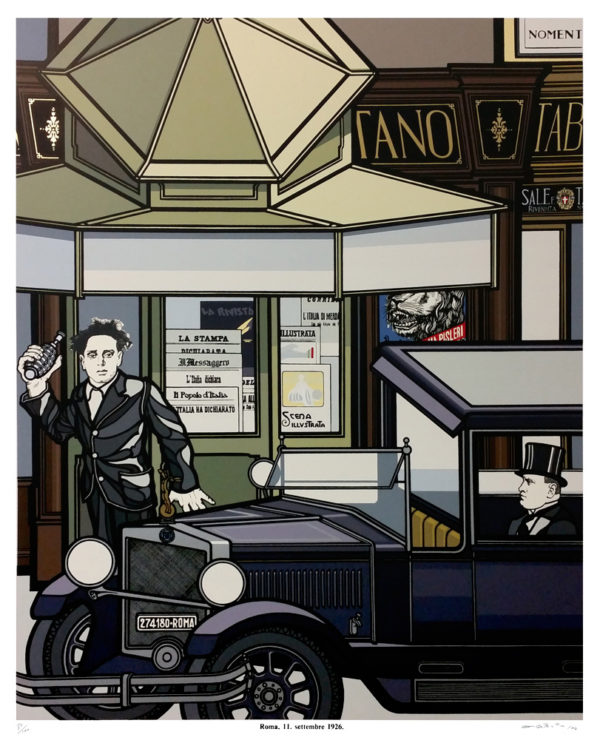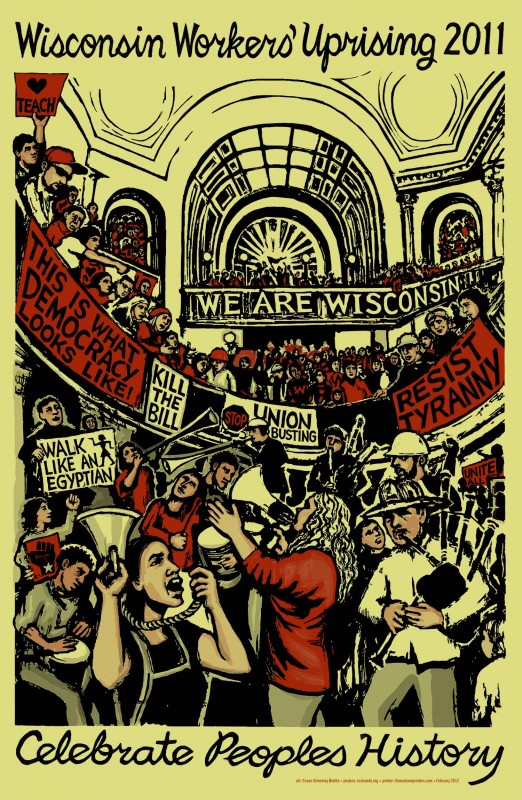By Kristin Smith
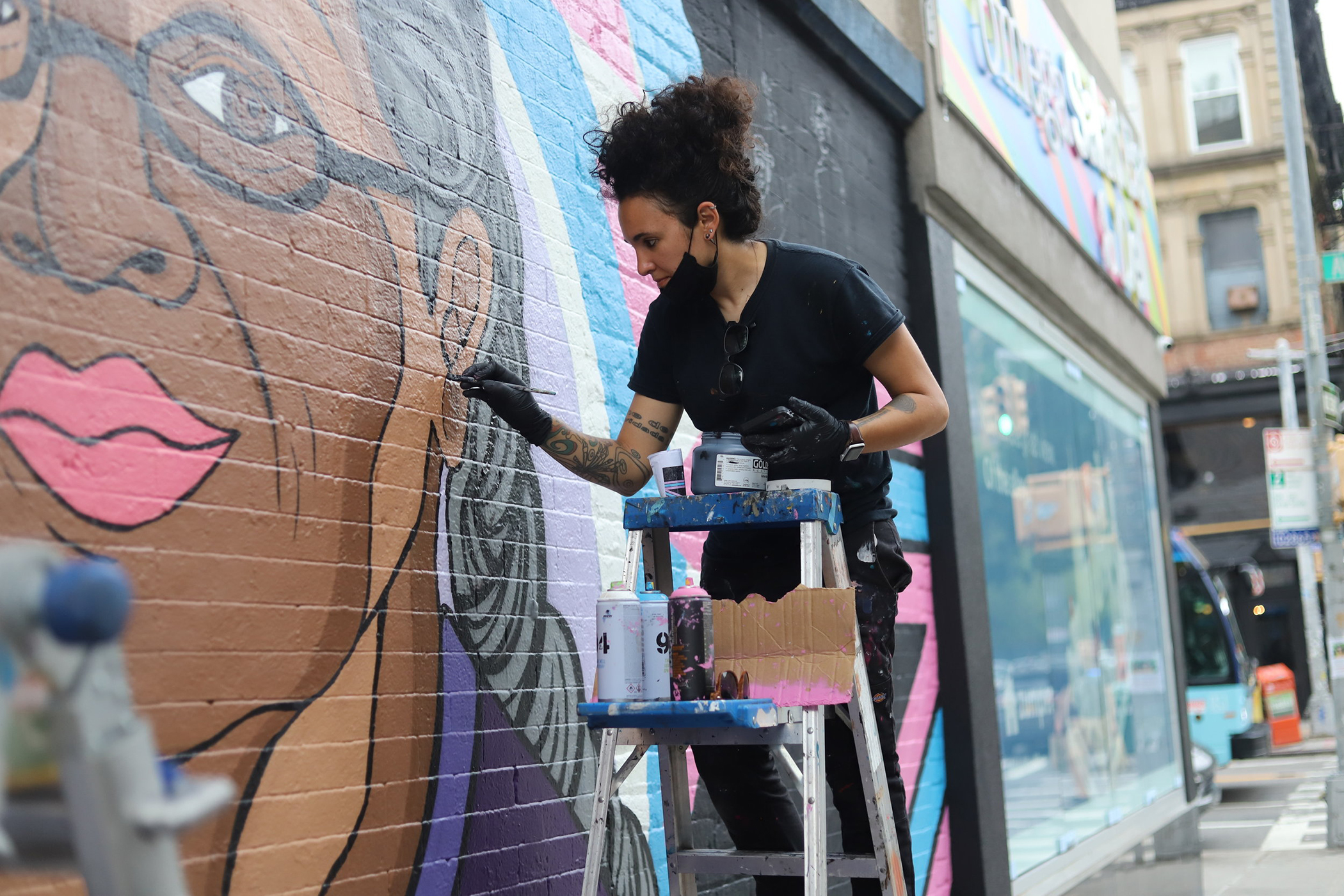
Sam Kirk is a multi-disciplinary artist based in Chicago, with both a studio practice and public art practice. Her work highlights the importance of community feedback and collaboration in public art, and lifts up the overlooked stories, experiences, and voices of underrepresented communities.
Last fall, Kirk took part in Networks of Resistance, an exhibition at Co-Prosperity Sphere in Chicago featuring activist artists and collectives from Chicago alongside collaborative projects from the Justseeds Artists’ Cooperative.
Kirk often works in collaboration with networks of community organizations, community members, and activists to create concepts for artwork that celebrates people and inspires pride and recognition for underrepresented communities. Her work walks the viewer through various moments, focusing on a celebration of culture, discovery of identity, and the politics that for generations people have been fighting for.
Kirk was born and raised on the south side of Chicago and spent most of her childhood jumping from neighborhood to neighborhood with her family. She enjoyed exploring new communities and cultures with each move, growing her fascination with the differences we all possess.
Working class communities continue to be her key ingredient of inspiration. Frequently exploring new destinations, her art is a continual study, sharing her experiences in the shifting landscapes of Chicago neighborhoods. Part autobiographical, and part fairytale, her vibrant color palette reveals profound stories laced with optimism.
Last year, Kirk’s work was selected by NYC Pride to wrap around the entire block of the main center stage in Times Square for the Closing Ceremony of World Pride. Her work was up for five days during the last week of Pride Month. The installation included five new designs by Sam Kirk and a design of a mural by Krik an Jenny Q completed for the Brooklyn Community Pride Center.
Kirk is now working on a campaign to repurpose the large-scale banners by donating them to LGBTQ organizations. You can learn more about the project here and nominate an organization that might benefit from this work!
Kristin Smith (K): Last year, you created an inspiring large-scale installation for World Pride in NYC? Could you share a bit about this project and how you are hoping to repurpose the materials from the project?
Sam Kirk (S): I designed banners that went up, and filled an entire block in Times Square for World Pride. Now I am donating all of that material to different LGBTQ nonprofits in the U.S. and around the globe. There are sixteen different banners that are being donated and we are trying to spread the word so that we can receive nominations for organizations where this work would be valuable. There’s a short form on my website where people can nominate organizations. I plan to begin sending the banners out this year, so I am trying to collect nominations now. I could select the organizations I’ve worked with, but I really want people to help make that decision. I’m especially interested in sending some of these to smaller cities where resources or budgets may not be as significant.

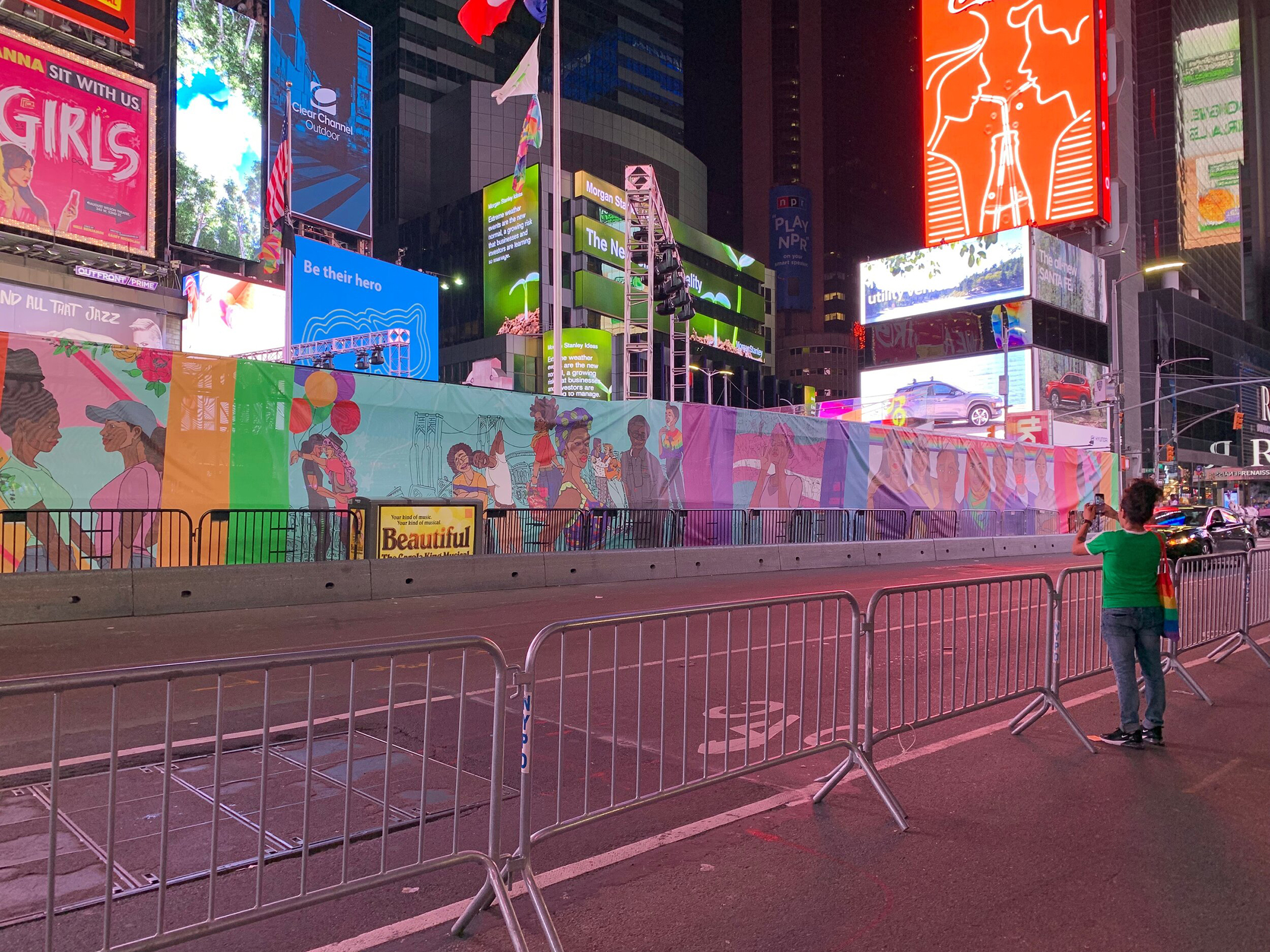
K: Murals and public art are a significant part of your practice. Their presence in communities and the everyday environment connects with people differently than art in a gallery. In what ways have you seen your public works spark a dialogue, start conversations. Have you seen interactions take place that wouldn’t be possible in other settings?
S: Yes, I’ve definitely seen this work sparking dialogue and conversation. The process of creating the mural sparks conversations about the content, process, and I feel is one of the best moments to learn about the residents in a community. The beauty in creating public art is that the community becomes part of the artwork. The surrounding elements contribute to the work in a way that is not possible if the same work was in a gallery or museum.
I love that public art is truly the people’s gallery. It’s in the street, so people are not required to go anywhere, they don’t have to enter any doors. There aren’t limitations to when it can be seen.
The content of the work presents an opportunity to contribute to conversations that are happening about politics and social justice issues. For me, one of the ways this happens is when we are creating the work, often, we engage with the community beforehand about what they would like to see more of in their neighborhood, or topics they feel need to be addressed. As we paint, we continue this conversation or learn of new topics with people passing by. Even long after the piece is completed, I find that people will pick up on different messages in the work and start a conversation online, reach out to me directly, or ask me to come talk about the artwork with students, community organizations, or companies.
People have also shared how the murals come up in conversations with their family or friends, which for me is part of the intention behind it – to spark dialogue.
Murals also provide a way to document a city’s history visually and publicly. Some of my favorite murals address social justice issues or political content. The narrative tells us what was happening at a given point in time in that community or the world.
In Chicago, this fascinates me because of the way that neighborhoods change—based on investment, development, and gentrification. The murals that surpass the change, remind us of what was once there–people and community culture. I think the residents of the neighborhood that were part of this history appreciate the murals because they sometimes remain even when the neighborhood has shifted.
K: I’m curious, since you’ve done a lot of murals especially in Chicago, to what extent does community input play a role in the content of these public works? How often does it become a collaborative process?
S: I try to include community conversation in the concept development phase as often as possible. It can vary based on the commission, but the community is always considered and the content is developed with the residents in mind. I always try to gather community input as part of the process, mostly because it is an opportunity to learn how people that reside in the neighborhood enjoy their community, changes they would like to see, or elements they want to celebrate. I feel strongly that the concept development process should be more than an individual decision.
And this process doesn’t have to be complicated. The process of collecting input can be as simple as gaining feedback from a small mix of community members or working with a local organization to help gather residents of the neighborhood together to have a conversation.
K: I thought it was interesting the way you use different color palettes to represent a multitude of races and cultures to make up a single person: Various tones of skin color or hair color, for instance. Are there other visual strategies or ways you use color to carry certain ideas, meanings, or feelings?
S: Yes, I’ll add different cultural elements or symbols that represent a specific community or neighborhood in the background. I’ve been asked to create murals that celebrate specific communities and I really try to include less common items along with familiar items. I want people to be curious about the details and present an opportunity to learn something new.
I’m biracial, and growing up in Chicago I often felt like I wasn’t seen in my community because I didn’t resemble the majority of people in the neighborhood. I’m really conscious of the segregation here and I am also focusing on creating work that is relatable to residents in nearby communities who also cross into the neighborhood where I am creating.
K: A lot of your work feels very optimistic: it celebrates and lifts people up. Would you say that positivity is an important element to you? Why? What other reactions might you want to spark from your work?
S: Positivity is definitely an extremely important element in the work that I create because the communities that my work celebrates are largely underrepresented. There are many negative images in the media and I feel the best way to challenge that is to share positive narratives about communities that are predominantly impacted. The south side of Chicago has a bad rap. I’m from here, and I want my work to share the other side of the story that people don’t get to hear. For communities of color, the LGBTQ community, and women to feel that they are celebrated in a way that is truly reflective of who we are as a community.
Some of the work I create is about very serious issues. For these works, I try to think about the people who are in those positions and how they will feel when seeing my work. It is a learning process. I’ve received feedback over the years that has challenged me and forced me to think about the content from many different perspectives.
I recently completed a mural that focuses on homelessness and 100% of the content was developed from three workshops I had with people who experienced homelessness at some point in their life or were currently experiencing homelessness. I had a long list of thoughts but I appreciated the challenge in figuring out how to use their stories to create a piece that was informative and inspiring. Informative to people who needed to learn more about the topic. And inspiring to those who may be experiencing homelessness.
K: Yeah, and celebrating people that are fighting these issues and surviving, rather than being downtrodden or struggling. I think that’s really powerful. Is there a public work in Chicago that you have felt most proud of, that you feel is especially impactful, or you feel is important for people to get out and see?
S: Right now I would say, there’s two that I did this year that I really want to mention. The mural I mentioned previously is for an organization called Lincoln Park Community Services (LPCS). It can be seen from the Sedgwick CTA Brown Line Station. The piece shares a narrative about homelessness from the perspective of the people that LPCS is working with to change their housing situation. If you start at the bottom, you will see some of the issues that lead to homelessness. I think it’s a really important piece.
While a lot of people think Chicago is an affordable city, that isn’t the case for everyone. Affordable housing is a huge issue and the mural addresses this while highlighting some of the ways LPCS has helped individuals experiencing homelessness to get back on track.
This mural process is a perfect example for the question that you asked about “How can we tie in community?” We completed three workshops for the concept development portion of this mural. The initial workshop was with individuals that are part of the LPCS community and they shared what they felt Chicagoans needed to know about their past, their journey, and some of the false assumptions that people make. I created the initial concept and presented it to LPCS staff and some of the same individuals along with new members for the second workshop. Once I made adjustments based on the feedback collected in the second workshop, I presented a new concept which they approved. In each workshop when I presented the work, I asked them “Do you feel that this communicates what you would like people to know about your experience with homelessness and in working with LPCS?”
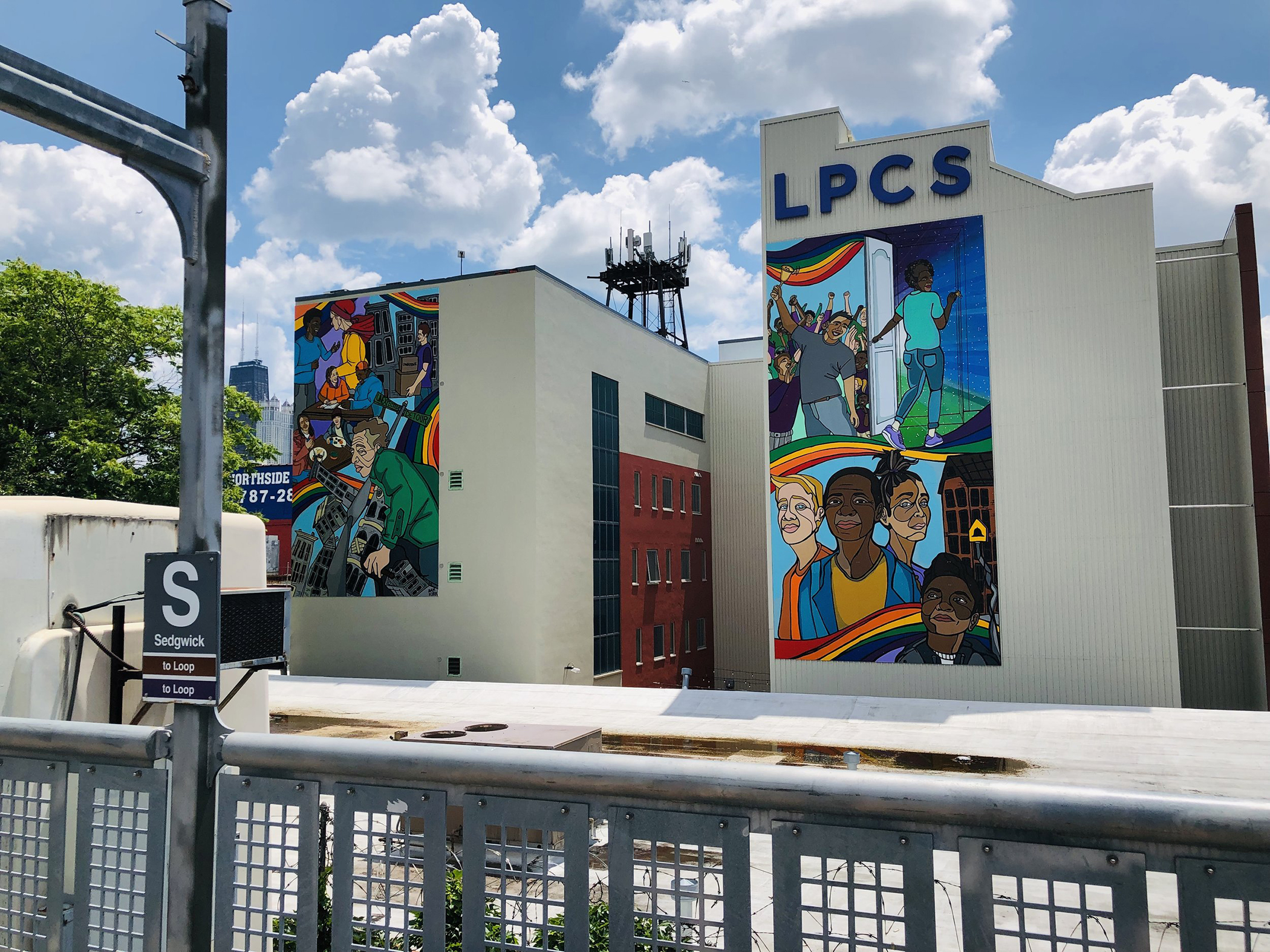
K: I know exactly the mural you are speaking of, which tells a narrative about experiencing homelessness. Ultimately, the woman gets keys to a home, and leaves a new community of people cheering her on. She opens the door to an entire universe in front of her.
S: Yes, that’s the one. So I’d say that one.
Then the other mural I’d mention is a piece I just finished on the Forum, which is in Bronzeville. That piece is of Nat King Cole, and while that piece didn’t include a community concept development phase, it still speaks to the community because of the history for the location where it is installed. The Forum is located on 43rd street and can be seen from the Green Line CTA station. I hope that the work inspires those who aren’t aware of The Forum to learn more about its significance to Chicago’s African American Community. The Forum was built in 1897, and contains one of the most important assembly and performance halls in the city and possibly the oldest hardwood ballroom dance floor in Chicago. This space played a significant role in Chicago’s cultural scene by hosting performances of music luminaries—including Nat King Cole—and by providing space for civic groups and political meetings. Urban Juncture is working to restore the building and my hope is that the mural will help to drive additional attention to the building and that one day it will be restored into a community center and gathering space again for Chicago and the Bronzeville community.
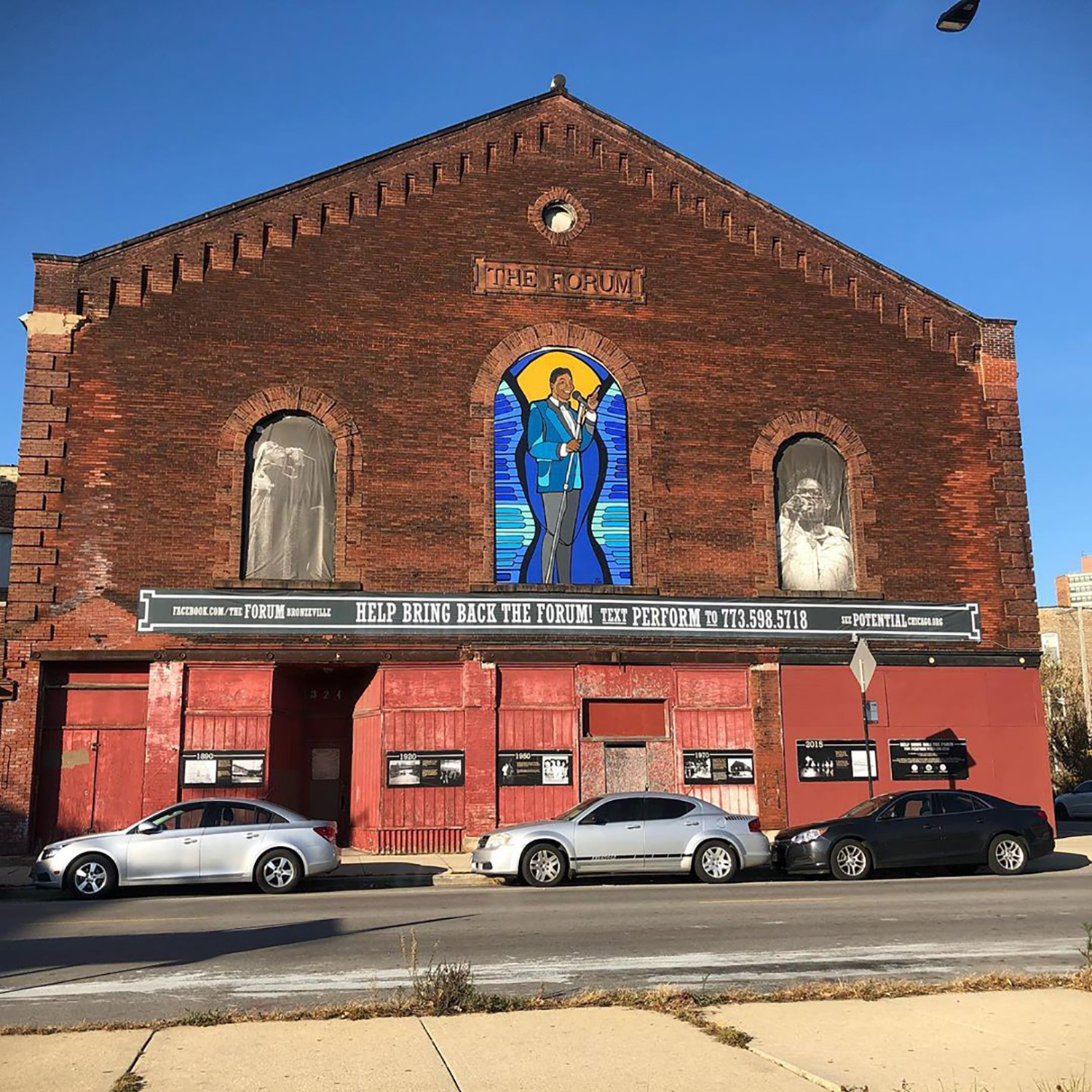
K: Are there any new directions or possibilities you see for your artistic practice, or any new forms of public installation you could see your work taking on in the future?
S: Yeah, I’m starting to play with some work that would be more three dimensional or sculptural. I don’t think I’ll ever stop painting murals because I really enjoy it but I want to take some of the work that I’m doing in my studio practice and bring it into the public space as well.
K: Speaking of your studio practice, are there any pieces from your studio practice you would want to highlight and share?
S: There’s a piece called “We keep showing up for America. When is American gonna show up for us?” It shares the role that women of color have played in organizations and through movements since the Black Panther Party to the present day in a fight for equality. The background references women marching with the Black Panthers and youth from Chicago’s BYP100. Both are in grayscale because not much has changed in the decades between these two movements – hence the question: “When is America gonna show up for us?”
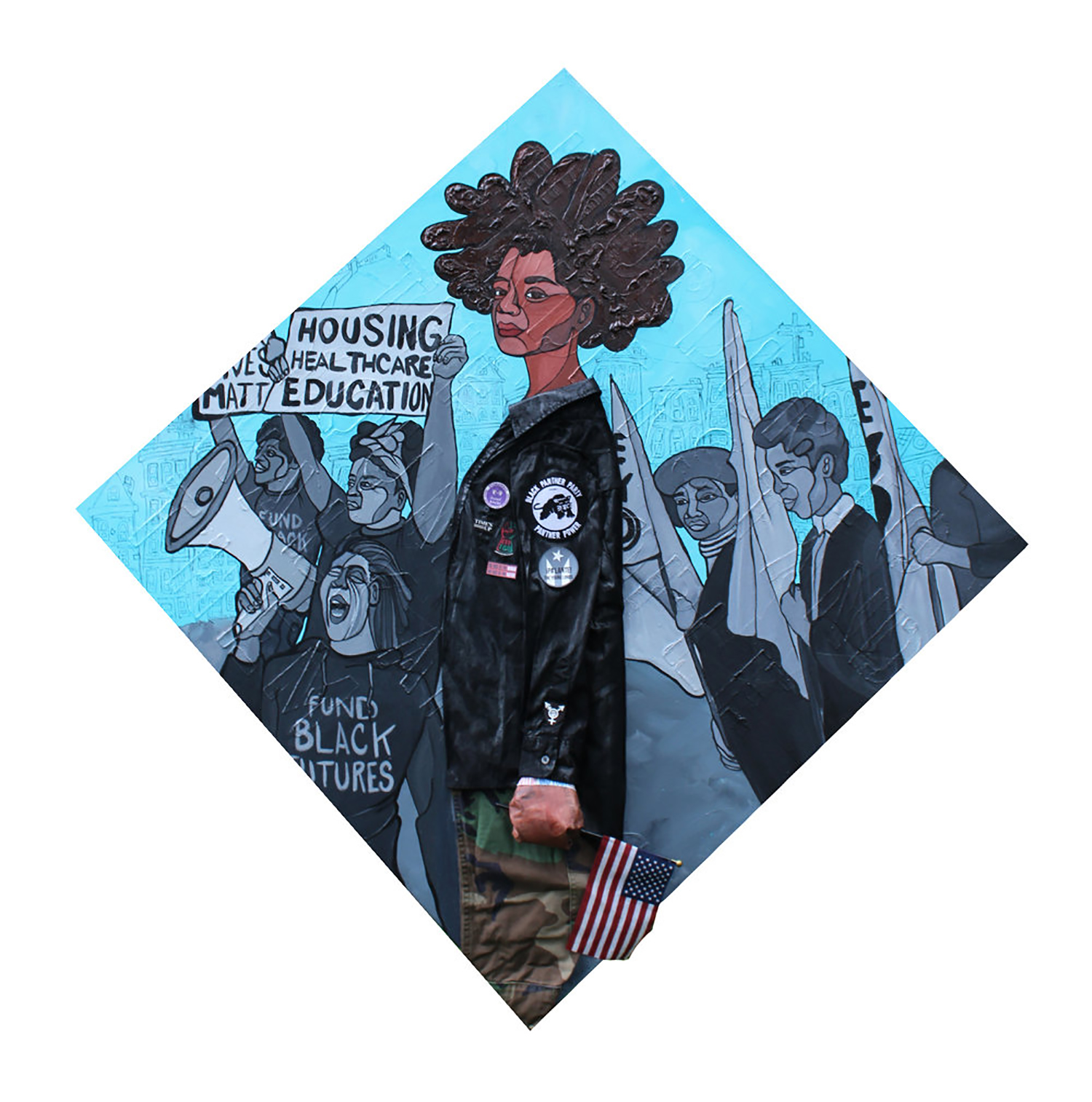
I’ve recently completed some stained glass work to highlight women of color in a way that I feel really represents a royalty and a power that should be celebrated. It’s a direction I am also exploring for my public art practice.
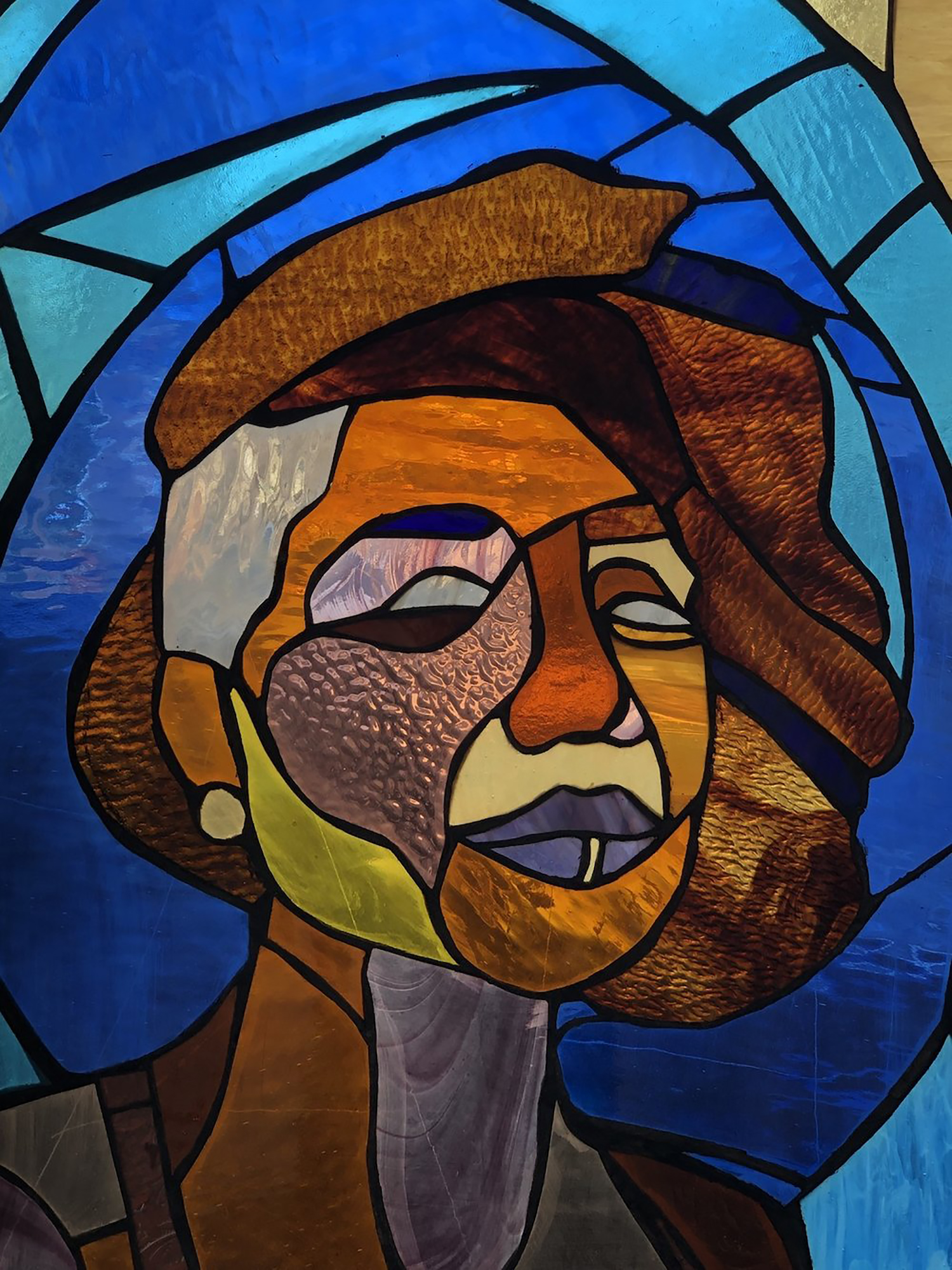
K: That sounds really interesting and I could definitely see the graphic quality of your murals translating well to that medium of stained glass.
S: Yeah, my challenge in this work is how to include the content and narrative in the stained glass without having to paint the glass. I’m not sure I want to paint glass. We’ll see.
Sam Kirk’s art reminds us that when engaging in difficult issues, even in times of struggle, there are stories of joy and resilience to be celebrated. You can learn more about her work and stay connected with Kirk through her website.
Links and Resources:
- Sam Kirk Website: iamsamkirk.com
- LGBTQ Art Banner Donation Program and Organization Nomination Form
- Donate to the Forum at 43rd in Bronzeville, Chicago: text “Forum” to 44321
- Sam was recently featured in Forbes for her work during World Pride 2019
- Sam featured in O Magazine for her overall art practice.
Kristin Smith is a graduate student at the School of Design at University of Illinois at Chicago. She took part in the Museum & Exhibition Studies course Showcasing Movement Graphics taught by Justseeds member Aaron Hughes. During the course students took part in organizing, curating, and installing the Networks of Resistance show which featured works by Sam Kirk. This interview was originally conducted in 2019 as part of that course and was edited for publication in 2020.

